Frizzle chickens are a ragged-looking chicken breed that makes a great addition to your backyard flock.
They have a curly plumage which makes them unique and easy to identify.
Though owners and breeders keep them as ornamental chickens, Frizzles easily produce eggs and meat, and brood, becoming productive members of your flock.
Read on to discover all there is to know about this fun-looking chicken!
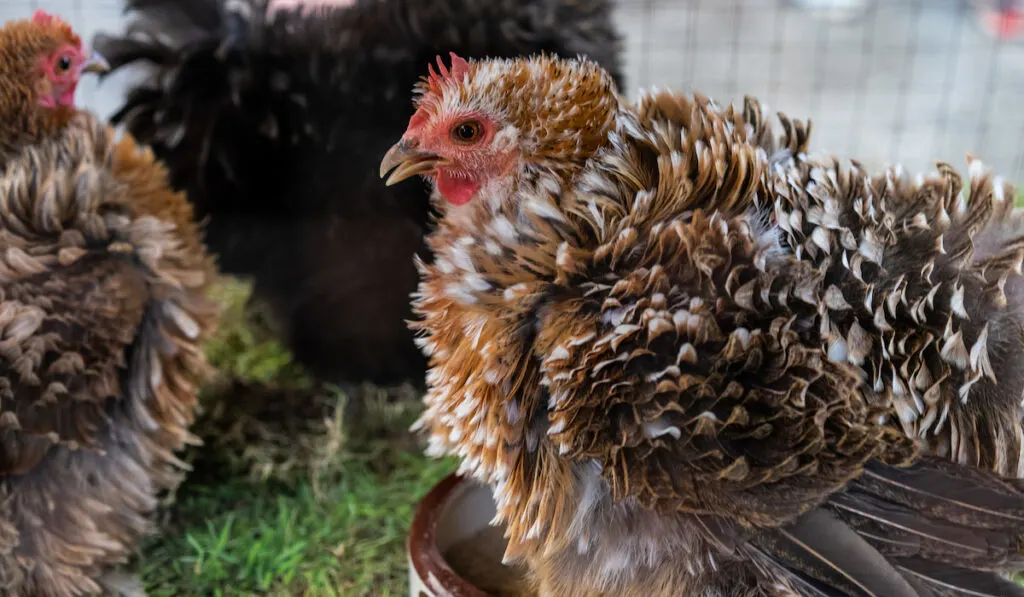
Table of Contents
History
Little is known about the origin of the Frizzle chicken breed. However, breeders believe that the Frizzle gene hails from Asia, as there are reports of Frizzle chickens in the Far East dating as far back as the 1700s.
It was not until the Frizzle chicken breed gained popularity that the first breeding stock reached most Western countries.
Today, Frizzle chickens are not recognized as a distinct or an individual breed in the United States.
As a result, they are judged by the standards of their primary breed during exhibitions.
However, Australia and several European countries recognize Frizzle chickens as a distinct chicken breed even though the Frizzle gene is present in many breeds such as the:
- Polish
- Japanese bantams
- Cochin
- Plymouth Rocks
Background
The Frizzle is a chicken breed known for its uniquely frizzled or curled plumage.
So, what is frizzling and why does it happen?
Frizzling is caused by the presence of an incomplete dominant gene.
This causes a chicken’s feathers to curl upward and outward or away from the body instead of lying against the body as is the case with regular chickens.
Essentially, the feathers’ shafts twist and curl, and this results in the ragged appearance of the feathers.
The presence of a single copy of the gene in one chicken is enough to cause frizzling. However, the presence of a copy in both parent birds can result in a high possibility of frizzles.
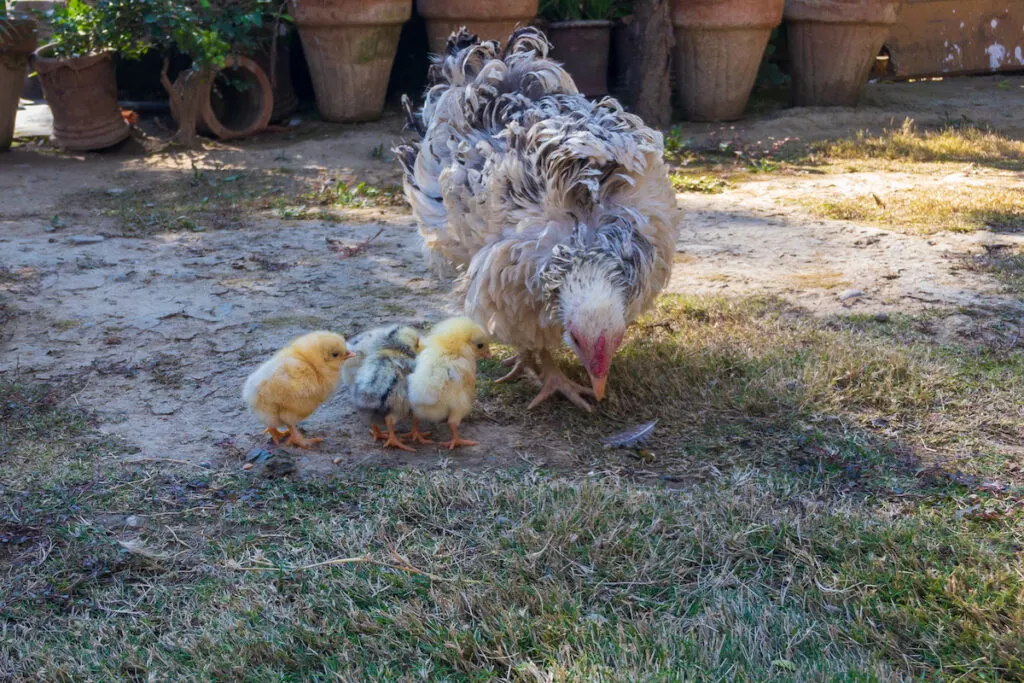
Breed Standard
As we have already established, Frizzle chickens are not recognized as a distinct chicken breed in the United States but rather as a type of plumage.
That said, breeders and owners can still exhibit them in showings, but only as exhibits of primary breeds like the Polish or Cochin.
The bird is then judged according to the standard for their specific breed.
For instance, bantam Cochin Frizzles are more competitive. They have a short bill resembling their plumage in color, bright red eyes, and medium-sized wattles and ear lobes.
The Cochin Frizzle’s body should be broad and upright with full breasts. They have featherless legs and feet with four toes on each.
Similarly, their combs should be upright, wings long, and tails upright.
Appearance
At first glance, Frizzle chickens appear as a walking plume of curly and wild feathers.
However, the feathers should appear wild and windswept or curly and tidy depending on the chicken breed in question.
Though they are twisted outwards, the feathers should still be seamlessly soft and not spiky.
Similarly, the chickens retain the shape of their breed with the only difference being in their feathering. Frizzle chickens are accepted in an array of colors including but not limited to:
- Black-red
- Buff
- Brown-red
- Black
- Blue
- White
- Columbian
- Spangled
- Cuckoo
- Red
- Duckwing
- Pyle
Though Frizzle chickens come in standard and bantam sizes, the bantam appears to be more popular today.
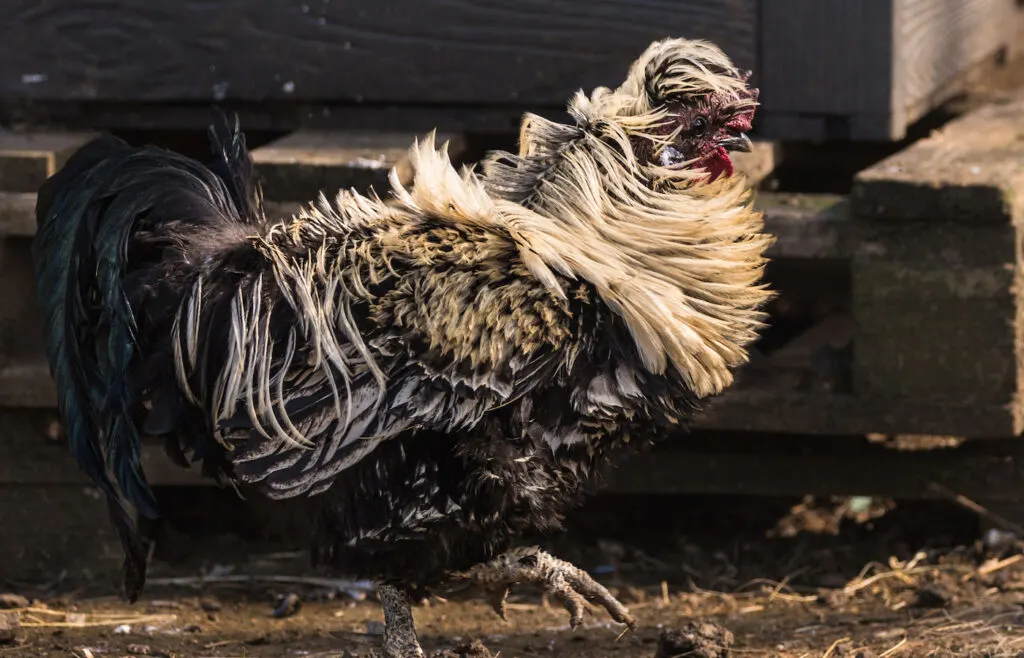
Size
As we have already seen, several breeds have the Frizzle gene or are prone to frizzling. Because of this, the average weight range for Frizzle chickens can vary significantly.
However, you can generally expect standard Frizzles to weigh between 6 and 8 pounds and bantams between 20 to 27 ounces.
That said, it is important to look at their parent breed to get a more accurate estimate.
Use
Though some people raise Frizzle chickens as ornamental birds for exhibition purposes, Frizzles make great general-purpose birds to add to your flock.
They are decent egg producers with exceptional brooding instincts.
They can also be raised for meat production, not to mention that their calm demeanor makes for a great pet.
Egg Production
The number of eggs a Frizzle can lay daily or on average depends on their actual breed. For instance, Cochin Frizzles may lay 2-3 eggs weekly, while Plymouth Rock Frizzles can lay 3-4 eggs in a week.
Frizzle chickens are also broody and make excellent mothers when they sit on their eggs.
Avoid breeding Frizzles together, that is, male and female Frizzles. This is mainly because they produce highly challenged offspring that often die within a few months.
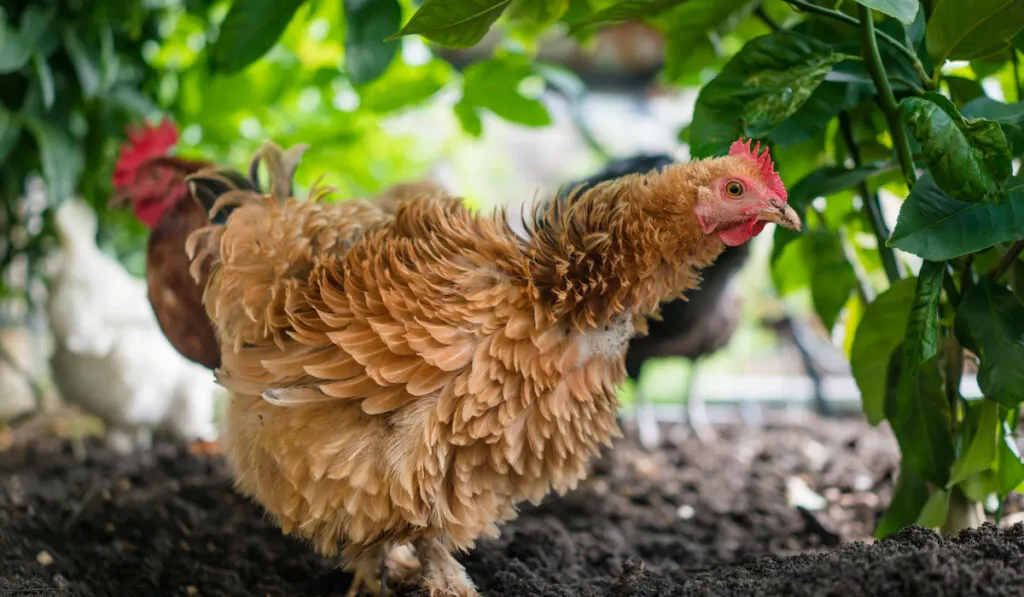
Varieties
All Frizzles should conform to the attributes of their breed. For instance, a Cochin Frizzle should look like regular Cochins. A Plymouth Rock Frizzle should look like regular Plymouth Rocks and so on.
This is the main reason why Frizzles are found in a variety of colors.
Temperament
Generally, you can expect Frizzles to be as sweet and bubbly as they look.
They have friendly and calm personalities that make them excellent and easy to raise.
Their quiet and easygoing nature makes them excellent pets, especially because they are tolerant to handling and easily become lap chickens.
Keep in mind, however, that there is a wide range of temperaments associated with this eye-catching breed — mainly because Frizzle chickens are usually different breeds in the US.
As a result, some non-Frizzle characteristics may show through.
Lifespan
Though somewhat high maintenance, Frizzle chickens can live for 6 to 8 years with the proper care.
Luckily, managing their ragged feathering and everything that comes with it is the only tasking bit of care.
Care and Maintenance
As intriguing as they are, the ragged look of the Frizzle chicken comes at a price. They are a fairly high-maintenance breed with intense needs.
Due to the unique nature of their feathers, Frizzle chickens require more care than other breeds.
For instance, the head feathering might overgrow and interfere with the chicken’s vision. Regular trimming of the feather tips will help the birds see better, but it is not allowed for exhibition birds.
This means that your Frizzles will have to do with obstructed vision if you are raising them exclusively as show birds.
Noise Levels
Frizzle chickens do not have a reputation for being rowdy or overly noisy. If anything, they are usually quieter than their standard counterparts.
That said, they can be quite talkative and enjoy one on one time with their owners.
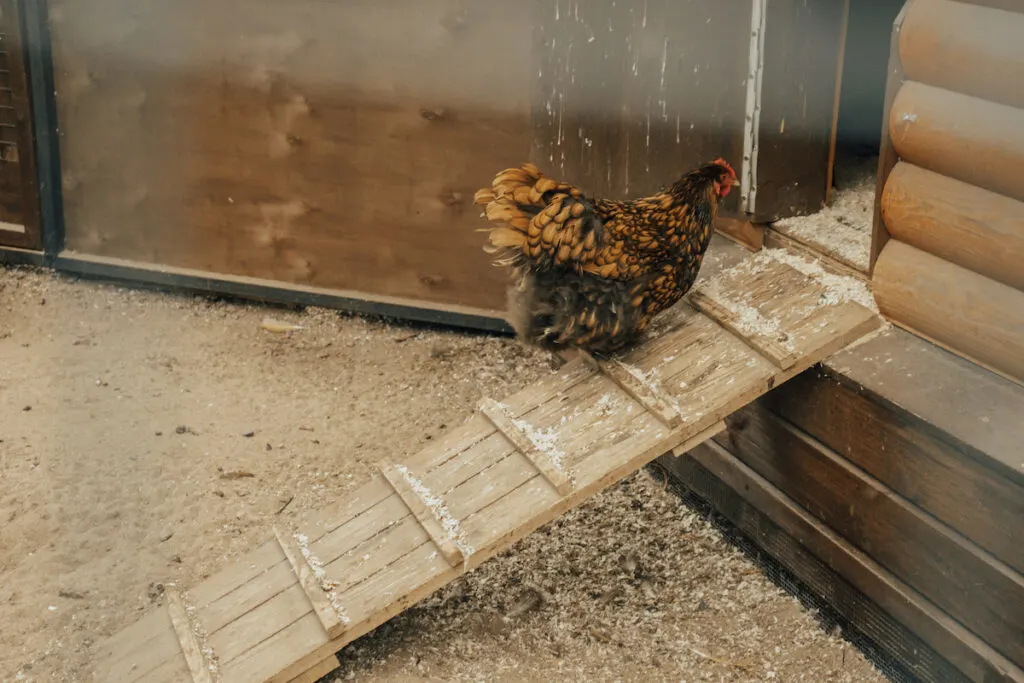
Housing
Each standard Frizzle Chicken needs at least 4 square feet of coop space while bantams need a little less space to thrive.
For roosting, each Frizzle should have 8–10 inches. Having roosting perches will ensure your Frizzles have enough room to move away when other breeds start to pluck them.
Remember to build the perches closer to the ground for easy access since Frizzles can’t fly. A ladder to get up to the perch will suffice too.
Frizzles love roaming around and will appreciate some free-ranging space.
Allowing them a few hours to roam each day will allow them to forage for themselves.
If you choose to keep them in a run, consider allocating 16 square feet for each chicken. Needless to say, the housing design should offer protection from predators.
Nutrition
Each Frizzle consumes around a quarter pound of feed per day. Luckily, they are great foragers when offered room to free-range.
You should, however, offer your flock a high-quality, 16% layer feed throughout the year.
You will also need to increase their protein intake by 18%–20% during their molt to meet their daily requirement and to help replace the feathers.
As with other livestock, you can incorporate extra calcium in the form of oyster shells into your Frizzles’ diet. It is best to offer this separately so the hens can feed on a need-to basis.
Insoluble grit is also a great supplement for chickens kept in a run.
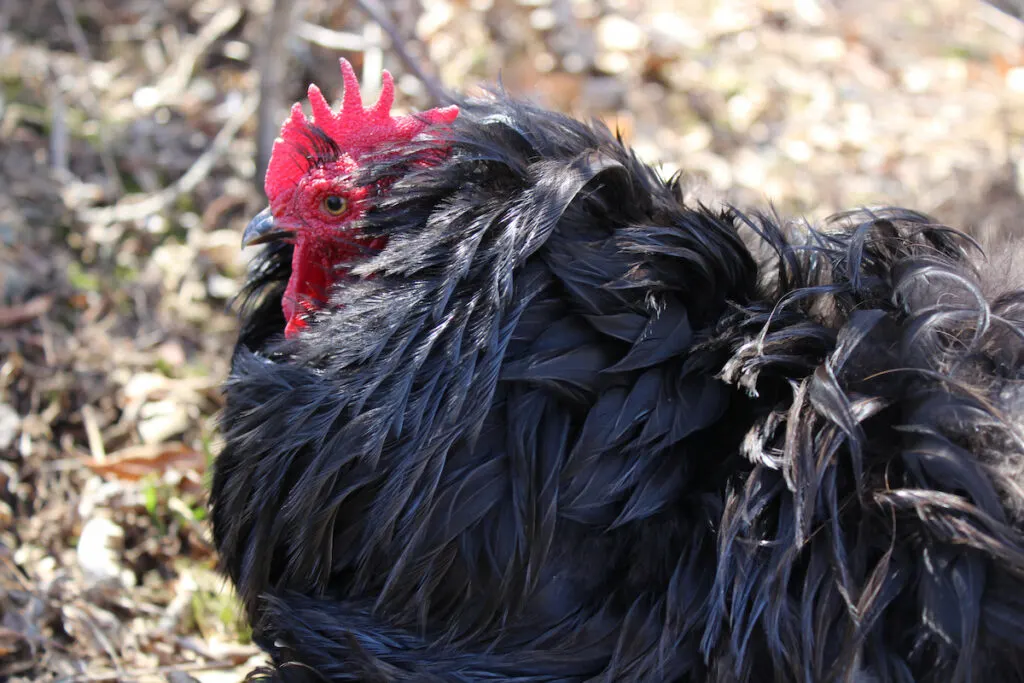
Common Health Issues
Frizzles are generally healthy and hardy chickens. But like other chickens, they are prone to mites and lice among other internal and external parasites.
Since Frizzle chickens’ feathers are fragile, it is important to regularly check for signs of feather plucking and or bullying by other flock members.
Similarly, Frizzle chickens are prone to cold-related health complications.
Since their feathers do not lay flat as with other chickens, Frizzles have a hard time staying warm in wet or cold conditions.
Therefore, should a Frizzle get soaked it should be dried and warmed swiftly. Otherwise, it runs the risk of suffering from hypothermia which could lead to death.
Final Thoughts
Unlike any other bird breeds, Frizzle chickens come in a variety of breeds. This allows you to choose the breed that works for you or that will be a feasible addition to your flock.
While Frizzles require extra care and attention, they make up for it in more ways than just their cute looks. It is, therefore, safe to say that Frizzles are a worthy addition to most if not all flocks.
Resources
- https://web.extension.illinois.edu/eggs/res10-breedhistory.html
- https://www.backyardchickencoops.com.au/blogs/learning-centre/breed-profile-frizzle
- https://www.thehappychickencoop.com/frizzle-chicken/
- https://en.wikipedia.org/wiki/Frizzle_(chicken_breed)
- https://www.roysfarm.com/frizzle-chicken/
- https://www.chickensandmore.com/frizzle-chicken/#Health_Issues
- https://breeds.okstate.edu/poultry/chickens/frizzle-chickens.html?Forwarded=afs.okstate.edu/breeds/poultry/chickens/frizzle/index.html//
